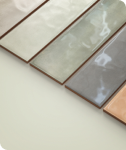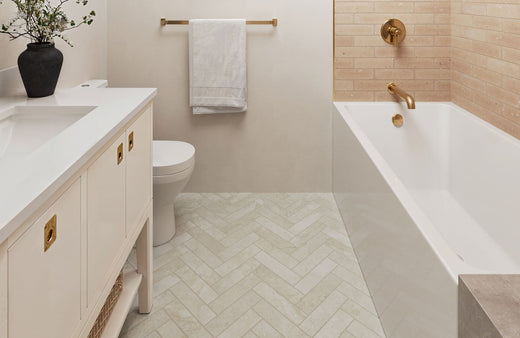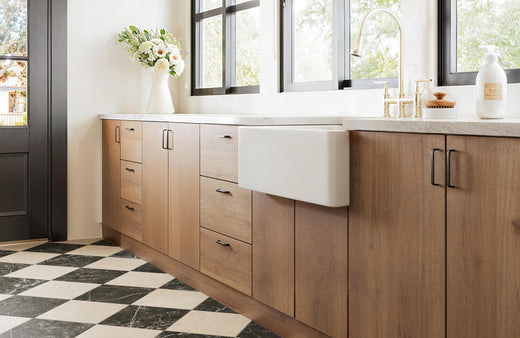Marble, a metamorphic rock celebrated for its beauty and durability, is found across the globe, with notable deposits in Europe, Asia, North America, and South America. With its smooth texture, striking patterns, and sculptural versatility, marble has been a cornerstone of art, architecture, and construction for centuries.
This article uncovers where marble is found, the geological forces behind its formation, the elements that define its unique characteristics, and a durable and practical alternative. For those seeking to blend timeless elegance with modern practicality, marble look tiles offer a seamless alternative, combining the beauty of natural marble with enhanced durability and ease of maintenance.

Global Distribution of Marble Deposits
Marble deposits are found worldwide, each region shaped by unique geological processes and histories that influence the characteristics of their marble.
Europe
Europe boasts a rich marble heritage, producing some of the world's most renowned varieties. Italy, for instance, is celebrated as the home of Carrara marble, renowned for its pristine white color and fine grain. This exquisite marble, famously used in Michelangelo’s masterpieces, symbolizes elegance and versatility. Greece, another prominent producer, offers Parian marble, highly prized for its translucency and delicate veining, which made it a favorite among ancient sculptors. Other notable European contributors include Turkey, Spain, and Portugal, each known for their distinct and unique marble varieties.
Asia
Asia’s diverse geological landscape is home to unique and highly prized marble deposits. In China, regions such as Fujian and Yunnan are celebrated for producing both white and colorful marbles adorned with intricate veining, making them a sought-after choice for artistic and architectural purposes. India stands out with Rajasthan, a region renowned for its vibrant pink and red marbles. These striking hues have made Rajasthan's marble a popular material in architectural and design projects, where boldness and elegance are desired. Meanwhile, Turkey is globally recognized for its Travertine marble. Known for its distinctive banded appearance, Turkish marble is ideal for a variety of applications, including floors, walls, and decorative elements, seamlessly combining beauty and durability.
North America
North America significantly contributes to global marble resources, with notable production in the United States and Canada. In the U.S., Vermont’s white marble stands out for its remarkable purity, while Georgia’s colored marbles are valued for their versatility, making them popular choices in various applications. Canada also plays a key role in marble production, with provinces like British Columbia and Ontario offering a diverse range of marble. Their deposits include white, grey, and green varieties, each prized for its unique characteristics and suitability for various uses.
South America
South America is known for producing marbles celebrated for their bold patterns and vibrant colors. Brazilian marble stands out with its striking veins and dramatic variations, making it a popular choice for luxury interiors. Similarly, Argentine marble is prized for its smooth texture and subtle veining, which harmonize beautifully with both classic and modern design aesthetics.

Marble in Art and Architecture
Marble’s timeless beauty and durability have made it an integral part of art and architecture across centuries, shaping some of the world’s most iconic creations.
In ancient Greece, marble played a vital role in temples and sculptures, with masterpieces like the Parthenon and Venus de Milo showcasing its cultural significance. Similarly, ancient Rome embraced marble for grand structures and intricate statues, exemplifying their mastery of this material in architectural and artistic endeavors. The Colosseum, among other enduring landmarks, reflects their exceptional craftsmanship.
During the Renaissance, marble experienced a revival as artists like Michelangelo brought it back to prominence through iconic works such as David and Pietà. This trend continued into the Baroque and Neoclassical periods, where marble’s luxurious appeal enhanced the grandeur of buildings like St. Peter’s Basilica, demonstrating its enduring allure through time.
In contemporary design, marble remains a staple, prized for its versatility and elegance. It is widely used in architecture, interior design, and sculpture, featuring prominently in flooring, countertops, and decorative accents for both residential and commercial spaces. Its timeless charm ensures its relevance in modern aesthetics while maintaining its historical prestige.

Geological Formation of Marble
As we explore where marble is found, understanding the natural processes behind its formation provides valuable insight into why certain regions produce such unique and sought-after varieties. Marble forms through the metamorphic transformation of limestone deep within the Earth's crust, where immense heat and pressure drive profound changes in the rock's structure and mineral composition. These processes determine marble’s strength, texture, and distinctive appearance.
The Metamorphic Transformation
Limestone, primarily composed of calcium carbonate (CaCO₃), undergoes profound changes during metamorphism. One of the most significant transformations is the recrystallization of limestone’s calcite crystals. Under immense pressure and high temperatures, these crystals interlock and grow larger, increasing the marble’s hardness, density, and resistance to weathering. This process refines its texture, contributing to its durability and aesthetic qualities.
Impurities within the limestone further influence the marble’s distinctive appearance. Clay minerals, rich in silica, create streaks and veins that enhance the material’s visual appeal. Similarly, iron oxides like hematite or limonite introduce subtle pinks, yellows, and bold reds or browns, adding dramatic variations to the stone’s coloration. Other minerals, such as magnesium, can impart green or blue hues, enriching the uniqueness of specific marble types.
Regional and Contact Metamorphism
Marble formation can occur through regional or contact metamorphism. Regional metamorphism takes place over vast areas and is primarily driven by tectonic forces, such as the collision of continental plates. These powerful geological events deform the Earth's crust, subjecting extensive limestone deposits to intense heat and pressure, which transforms them into marble. This process is evident in the formation of mountain ranges like the Himalayas and the Alps, where extensive marble deposits are embedded within their geological layers.
Contact metamorphism, on the other hand, occurs due to localized interactions with rising magma. As magma intrudes into surrounding rocks, the intense heat it generates transforms limestone into marble. This process typically results in smaller marble deposits, with their size and quality depending on the temperature and the proximity to the magma intrusion.

Marble Mining and Extraction
Advancements in quarrying techniques have revolutionized marble extraction, enhancing efficiency while mitigating environmental impacts. These improvements have streamlined operations and addressed concerns related to sustainability and worker safety.
Historically, quarrying relied heavily on manual labor and rudimentary tools such as chisels, wedges, and explosives. While these traditional methods were effective in extracting marble, they posed significant environmental risks and safety hazards. The labor-intensive process often led to considerable waste and disruption of surrounding ecosystems.
Modern techniques have introduced precision tools and advanced technology to the quarrying process. Diamond wire saws allow for accurate cutting, minimizing waste and reducing vibrations that can damage the stone. Automation through robotic systems further improves accuracy and worker safety, taking over tasks like cutting and drilling. Additionally, remote sensing and 3D modeling technologies have optimized quarrying operations by reducing environmental impacts and improving overall efficiency.
Despite technological advancements, marble quarrying still poses challenges to the environment. Activities like deforestation, erosion, and waste generation can harm ecosystems if left unchecked. Sustainable practices, including reforestation, erosion control, and water treatment systems, are essential to minimize these effects and ensure responsible extraction processes.

Marble Look Tiles: A Practical Alternative
For those seeking the elegance of marble without its challenges, marble look tiles offer a durable, cost-effective solution. Crafted from porcelain or ceramic, marble look tiles mimic natural marble with stunning realism while offering superior durability and minimal maintenance. Their resistance to scratches, stains, and moisture makes them ideal for high-use areas.
These tiles are highly versatile. Indoors, they are perfect for floors, walls, and backsplashes in kitchens and bathrooms. Outdoors, porcelain marble look tiles excel in patios, pool decks, and outdoor bathrooms, offering durability and style. In commercial spaces, they provide a practical balance of beauty and functionality, ideal for lobbies and interiors.
Advancements in digital printing have enabled manufacturers to replicate intricate marble patterns, reducing the need for quarrying natural marble. Eco-friendly production processes and the versatile designs of marble look tiles make them a sustainable choice that aligns with modern design trends.
Among these options, the Aniston 24x48 Matte Porcelain Tile in Calacatta Antico, as displayed in the picture above, stands out for its soft veining, matte finish, and timeless appeal. Perfect for both indoor and outdoor settings, it seamlessly complements traditional and contemporary styles, making it an elegant choice for living spaces, kitchens, bathrooms, or even luxurious hotel lobbies.
To make selecting the right tile even easier, Edward Martin offers an innovative augmented reality (AR) tool. This cutting-edge feature lets you visualize how tile collections like Aniston will look in your space, helping you make confident design decisions with ease. Whether you're designing a cozy home or a grand commercial project, this tool simplifies the process, blending convenience with creativity.
Preserving Marble’s Legacy for the Future
Marble, formed through complex geological processes, has captivated civilizations with its beauty and versatility. From ancient masterpieces to modern interiors, its timeless appeal endures. While natural marble continues to inspire, marble look tiles offer a sustainable, practical alternative, replicating its elegance with durability and low maintenance. Combining responsible marble extraction with the thoughtful use of these innovative alternatives ensures marble’s legacy remains relevant for future generations.
To help you achieve your design goals, Edward Martin offers personalized services tailored to bring your vision to life. From handpicked samples to one-on-one consultations with professional designers, every detail is thoughtfully addressed. Our team’s support spans from the initial concept to final product delivery, ensuring a seamless and collaborative experience. Whether you’re designing a cozy home or a grand commercial space, Edward Martin provides expert guidance every step of the way.







